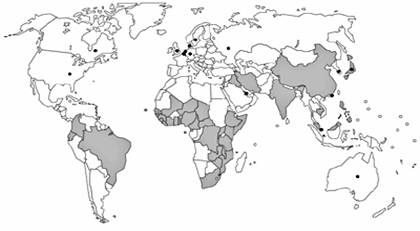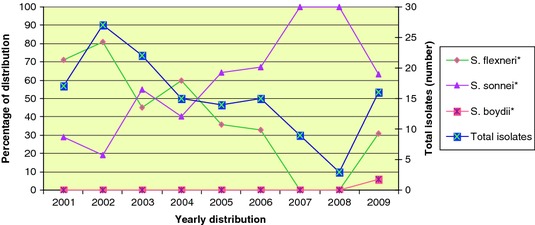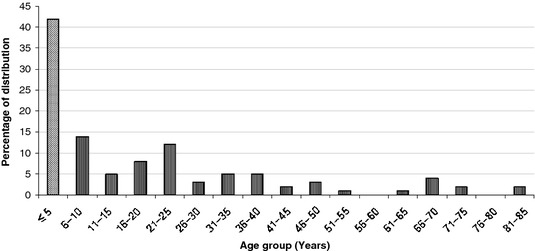Habitat
Where is its humble abode?
Shigella sonnei
lives in low pH environments like the human intestinal tract.
The ideal temperature
 for this organism is
37 degrees Celsius which is about the
temperature
of the human body. It can survive in fecal matter, but
only for a short period of time. It is known to have survived up
to seven weeks on soiled linen. In freshwater environments,
Shigella sonnei can survive up to five days. In saltwater
environments, this organism can survive anywhere from 12 hours to 30
hours. The picture above shows the distribution of Shigella
sonnei infection across the world. There are very high
rates in undeveloped nations such as Africa and southern Asia.
for this organism is
37 degrees Celsius which is about the
temperature
of the human body. It can survive in fecal matter, but
only for a short period of time. It is known to have survived up
to seven weeks on soiled linen. In freshwater environments,
Shigella sonnei can survive up to five days. In saltwater
environments, this organism can survive anywhere from 12 hours to 30
hours. The picture above shows the distribution of Shigella
sonnei infection across the world. There are very high
rates in undeveloped nations such as Africa and southern Asia.
Species Distribution
There are many different organisms that
live in the human intestine.
E. coli and
Salmonella are two major bacterial infections, but there
are also parasitic infections such as
Giardia.
In the graph
 below, it shows the distribution
of each type of Shigella in a high infectious area. Shigella
sonnei gradually has become more pervalent over the years, where
as every
other type of Shigella has decreased or stayed low for the most
part.
below, it shows the distribution
of each type of Shigella in a high infectious area. Shigella
sonnei gradually has become more pervalent over the years, where
as every
other type of Shigella has decreased or stayed low for the most
part.
Age Distribution
The table below shows the distribution of the Shigella sonnei
infection by age. As you can see, children younger than five are
the most viable for the infection because they are not toilet trained and
 they are always around other children, which can spread the
infection. The infection rate for six to ten year olds is about a
third of the risk of younger children. This rate decreases so
quickly because these children are almost all toilet trained and are
normally enrolled in a more structured educational system then just
playing which tends to spread less germs.
they are always around other children, which can spread the
infection. The infection rate for six to ten year olds is about a
third of the risk of younger children. This rate decreases so
quickly because these children are almost all toilet trained and are
normally enrolled in a more structured educational system then just
playing which tends to spread less germs.
Now that we have seen globally where Shigella is located, lets take a look at its' adaptations!
